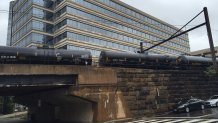Maureen Cohen Harrington lives next to the CSX tracks along the Virginia Avenue corridor in Southeast. When she heard about the derailment near the Rhode Island Metro Station, she started snapping pictures of the trains passing near her home.
Within just a few hours of the derailment, Harrington’s pictures show at least three chlorine tanker cars moving along the Virginia Avenue corridor near L’Enfant Plaza. You can clearly see large lettering and placards that typically warn first responders the cars contain the deadly gas.

As part of the News4 I-Team’s 2015 “Dangerous Cargo” investigative series, we showed how toxic chemicals routinely move along CSX rail lines near high-profile tourist attractions and government buildings. The I-Team found some of these tankers require a mile-wide evacuation zone if they derail, prompting local lawmakers to ask why the haz mats even need to move through the city at all.
CSX told the I-Team in a statement that it “places the highest priority on safety and the safe transportation of hazardous materials” and “assigns weighting to such factors as distance between shipping points, high threat urban areas traversed, and certain iconic locations, along with more than 20 other safety security considerations.”
Following a photograph of a chlorine tanker car moving past the U.S. Capitol Building following 9-11, CSX told the News 4 I-Team it stopped transporting chlorine through the nation’s capital.
When the I-Team asked about these new photos, CSX reiterated it does not transport chlorine and other “toxic inhalation/poison by inhalation products,” as well as “certain classes of explosive and spent nuclear fuel” through the nation’s capital.
Local
Washington, D.C., Maryland and Virginia local news, events and information
But CSX said it “does move empty rail cars that previously contained high-hazard materials through the District.”
But Harrington said, “even ‘empty’ cars are not really empty,” and worries if there’s still enough chlorine left in the tankers to be dangerous.
Read below for the full statement from CSX:
"CSX places the highest priority on safety and the safe transportation of hazardous materials. The company’s processes for hazardous materials transportation comply with all federal regulations, including those of the U.S. Departments of Transportation and Homeland Security.
Across the industry, movements of hazardous materials are routed in accordance with the Rail Corridor Risk Management System, an analytical tool developed in coordination with the federal government, including the U.S. Department of Homeland Security (DHS), U.S. Dept. of Transportation Pipeline and Hazardous Materials Safety Administration (PHMSA), the Federal Railroad Administration (FRA) and other railroads, that takes into account 27 factors about potential routes. This routing tool assigns weighting to such factors as distance between shipping points, high threat urban areas traversed, and certain iconic locations, along with more than 20 other safety and security considerations.
Consistent with the DOT’s routing tool, CSX does not move certain categories of hazardous materials through the District, including the Virginia Avenue Tunnel. Those materials include toxic by inhalation/poison by inhalation products, certain classes of explosives and spent nuclear fuel. CSX does move empty rail cars that previously contained high-hazard materials through the District.
DOT assesses CSX’s hazardous materials routes and conducts reviews and audits. Those audits have confirmed that CSX is in compliance with its shipments of hazardous materials.
CSX’s commitment to safety is built on a foundation of significant investment in the maintenance and improvement of its infrastructure and equipment, the deployment of technology to monitor and prevent accidents, and training of its employees at its Railroad Education and Development Institute along with in-service training.
In addition, CSX regularly conducts training with first responders to ensure the highest level of coordination and familiarity with railroad equipment and the hazardous materials carried. Those hazardous materials are key inputs for many manufacturing processes and consumer goods, and CSX complies with its common carrier obligation to move any freight tendered in a safe rail car."



